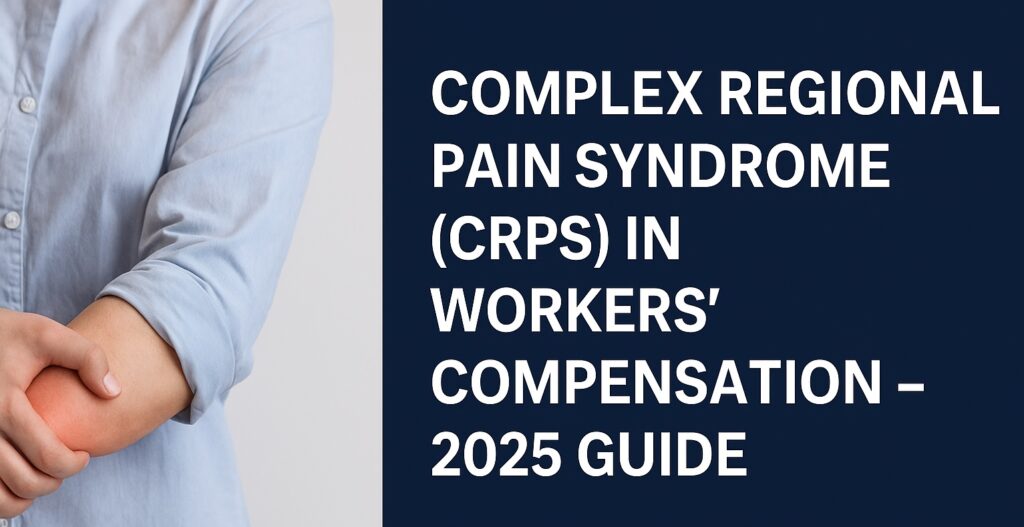
What Is CRPS?
Complex Regional Pain Syndrome (CRPS) is a serious and often misunderstood chronic pain condition that can develop after even a relatively minor workplace injury. It is characterized by prolonged, excessive pain that is disproportionate to the original trauma, accompanied by neurological, vascular, and musculoskeletal symptoms that can worsen over time.
CRPS typically begins in one limb—often a hand, arm, foot, or leg—but can spread to other areas of the body. It affects the nervous system’s ability to regulate pain signals and blood flow, causing physical and functional impairments that can severely impact an injured worker’s ability to work or live independently.
In California, CRPS is recognized as a compensable condition under the workers’ compensation system. But because it is complex to diagnose, difficult to treat, and not always visible in standard imaging, it is frequently denied, delayed, or downplayed by insurance carriers.
At Employees First Labor Law (EFLL), we specialize in advocating for injured workers diagnosed with CRPS. We work closely with pain specialists, Qualified Medical Evaluators (QMEs), and treating physicians to ensure our clients receive the full scope of medical care and compensation they are entitled to under California law.
Symptoms of CRPS
CRPS symptoms can appear within days or weeks of an injury, or develop gradually. Hallmark signs include:
- Severe, continuous burning or stabbing pain
- Pain disproportionate to the initial injury
- Hypersensitivity to touch or cold (allodynia)
- Swelling and joint stiffness
- Discoloration or shiny, thin skin
- Temperature changes (hot or cold) in the affected area
- Abnormal sweating or changes in hair/nail growth
- Decreased mobility and muscle atrophy
These symptoms can fluctuate but tend to worsen over time if not treated aggressively and early.
Types of CRPS:
- Type I (Reflex Sympathetic Dystrophy): Occurs after an injury with no confirmed nerve damage
- Type II (Causalgia): Follows a confirmed nerve injury
Both types are recognized under California workers’ compensation law and can result in significant permanent disability if not properly managed.
CRPS and Workers’ Compensation in California
While CRPS is compensable, insurers often delay or deny care due to skepticism or misunderstanding of the condition. Unlike a broken bone or torn ligament, CRPS does not always show up on MRIs or X-rays. That means insurers often claim it’s “subjective,” “exaggerated,” or “psychosomatic.”
To succeed in a CRPS claim, you must have:
- A clear diagnosis by a specialist (typically a neurologist, pain management physician, or QME)
- Documentation linking the onset of symptoms to your work injury
- Evidence that your symptoms meet the Budapest Criteria for CRPS (recognized by MTUS and AMA guidelines)
Common Work Injuries That Trigger CRPS
CRPS can develop after nearly any physical trauma, including:
- Crush injuries to hands or feet
- Wrist or ankle sprains and fractures
- Surgical interventions (especially post-operative complications)
- Carpal tunnel surgery
- Repetitive stress injuries to nerves or joints
- Burns, lacerations, or needlestick injuries in healthcare jobs
Importantly, the severity of the initial injury does not predict the severity of CRPS—a minor sprain could lead to major pain dysfunction.
The Dangers of Delay
Time is critical in CRPS cases. The first 3–6 months after symptom onset are the “golden window” for effective treatment. Early diagnosis and aggressive intervention can dramatically improve outcomes.
Delays often occur because:
- Insurers minimize pain complaints
- Primary treating physicians misdiagnose CRPS as a simple strain or contusion
- Referrals to specialists (e.g., neurologists) are denied or delayed
- Requests for diagnostic tools like triple-phase bone scans, EMG/NCS, or thermography are not authorized
At EFLL, we push back on delays and make sure injured workers receive appropriate diagnostic testing and specialist referrals immediately.
Approved Treatments for CRPS Under MTUS
California’s Medical Treatment Utilization Schedule (MTUS) recognizes CRPS and provides treatment guidelines aligned with ACOEM standards. Approved treatments include:
- Nerve blocks (sympathetic ganglion blocks)
- Topical analgesics (NSAIDs, lidocaine, capsaicin)
- Oral neuropathic agents (gabapentin, pregabalin, amitriptyline)
- Functional restoration programs
- Physical therapy (desensitization, graded motor imagery, mirror therapy)
- Cognitive Behavioral Therapy (CBT)
- Spinal cord stimulation (in severe, treatment-resistant cases)
Opioid therapy is discouraged and only allowed under strict conditions, including documented functional improvement and tapering plans.
Common Challenges in CRPS Workers’ Comp Cases
- Denial of the diagnosis as “exaggerated” or “non-industrial”
- Inadequate referrals or inappropriate treatment delays
- Lack of understanding by adjusters or nurse case managers
- Disputes over causation due to delayed symptom onset
- Denial of expensive or cutting-edge treatments like spinal cord stimulators
- Poor documentation by primary treating physician
EFLL’s Legal Strategies for CRPS Clients
CRPS cases require advanced legal handling and strategic medical coordination. At EFLL, we:
- Immediately demand referral to appropriate pain management and neurology specialists
- Work with physicians to draft MTUS-compliant RFAs to reduce UR denials
- Challenge denials through Utilization Review (UR) and escalate to Independent Medical Review (IMR)
- Secure QME or AME evaluations from pain or neuro experts
- Ensure permanent disability ratings reflect the chronic and limiting nature of CRPS
- Push for future medical provisions in settlements, including lifetime care for pain management
We have litigated and resolved numerous CRPS cases involving misdiagnosis, denied surgeries, and improper delays in care.
What Is a CRPS Workers’ Comp Case Worth?
CRPS cases can lead to significant financial recovery, depending on the severity and long-term impact. Factors that influence value:
- Permanent Disability Rating (PDR)
- Need for lifetime medical care
- Inability to return to pre-injury job
- Ongoing medication or pain management regimen
- Vocational retraining eligibility
- Loss of future earning capacity
Estimated Settlement Ranges:
| CRPS Severity | Estimated Settlement Value |
|---|---|
| Mild (conservative care, return to modified work) | $25,000 – $50,000 |
| Moderate (ongoing pain management, job restrictions) | $50,000 – $150,000 |
| Severe (permanent work restrictions, spinal cord stimulator, psych involvement) | $150,000 – $500,000+ |
| 100% Permanent Disability (total loss of earning capacity) | Lifetime benefits – $1M+ present value |
Each case is fact-specific. At EFLL, we work to maximize value through proper documentation, specialist input, and aggressive litigation when necessary.
Tips for Injured Workers with Suspected CRPS
- Act fast – Insist on referrals to a neurologist or pain specialist within weeks of symptom onset.
- Track your symptoms – Keep a daily pain diary with photos of swelling, discoloration, or movement limitations.
- Don’t downplay your pain – Clearly describe hypersensitivity, burning, and functional loss.
- Avoid gaps in treatment – Missed appointments can be used to justify denials.
- Work with a CRPS-savvy legal team – Standard claim handling is not enough for a CRPS case.

Final Thoughts
CRPS is not just a painful diagnosis—it’s a life-altering condition that demands skilled legal and medical intervention. If you’re facing delays, denials, or insurance companies that don’t believe you, Employees First Labor Law is here to fight for you.
We know how to document your condition, connect you with the right experts, and hold insurance carriers accountable. Whether you’re just developing symptoms or struggling with years of untreated CRPS, we’ll make sure your condition is taken seriously, your care is authorized, and your settlement reflects what you’ve truly lost.



